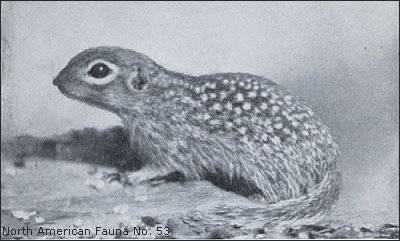

Most small mammals are inactive during the day, coming alive, so to speak, only as the lights dim. There is one major exception in our desert, though--members of the squirrel family. Most members of this nearly worldwide group sleep the nights away and cavort only in the sun's bright light. In the Chihuahuan Desert with its few trees, our squirrels are mostly ground squirrels and prairie dogs. These rely on burrows dug for protection against raptorial birds and furred predators—but pity the burrow occupant trapped by a snake.
The Spotted Ground Squirrel is often seen on its haunches along the
side of roads in desert basins, but usually is absent from rocky areas. This small
squirrel, basically tannish but tending toward whatever color blends in with the
regional soils, has lighter colored spots distributed more or less randomly over its
back. The Mexican Ground Squirrel of the eastern Chihuahuan Desert looks similar, but
the spots are arranged in rows. Neither is apt to be mistaken for the much larger and
somewhat pudgy prairie dogs.

Contributor: Arthur H. Harris, Laboratory for Environmental Biology, Centennial Museum, University of Texas at El Paso.
Desert Diary is a joint production of the Centennial Museum and KTEP National Public Radio at the University of Texas at El Paso.
<<img class="rule" src="ruleahh.gif" width="95%" height="2" alt="rule" />
Spotted Ground Squirrel (Spermophilus spilosoma). After Bailey (1931).
Bailey, V. 1931. Mammals of New Mexico. North American Fauna 53:1-412.
Findley, J. S. 1987. The natural history of New Mexican mammals. University of New Mexico Press, Albuquerque. 164 pp.
Black-tailed Prairie Dog, The Mammals of Texas—online edition.
Mexican Ground Squirrel, The Mammals of Texas—online edition.
Rock Squirrel, The Mammals of Texas—online edition.
Spotted Ground Squirrel, The Mammals of Texas—online edition.
Texas Antelope Squirrel, The Mammals of Texas—online edition.